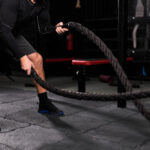When you first see someone smashing battle ropes, it looks like pure brute force. Shoulders pumping, ropes slamming, sweat flying. But before you try it yourself, the question hits: are battle ropes cardio or strength training? When and in which circumstances should you do this exercise?
Battle ropes are more cardio training than typical strength training. But you’ll still be able to improve your strength, just not the way you think.
Are Battle Ropes Cardio or Strength Training – Detailed Breakdown
Battle ropes feel like cardio, and for good reason. A proper session will have your heart rate spiking within seconds. The principle behind the movement is short bursts of explosive energy. The same style you’ll find in most HIIT workouts.
Sure, you’re holding heavy ropes, but think about it: rowing machines, kettlebell swings, even dumbbell circuits all use some form of resistance. And yet, in practice, those workouts are considered primarily cardio.
Battle ropes fall into the same category. They torch calories, improve stamina, and push your endurance threshold higher, so it makes sense to classify them as more cardio/endurance training than pure strength work.
How Do Battle Ropes Work as Strength Training?
Battle ropes do tap into the strength side of training, just not in the way a barbell bench press or a heavy squat would. You’re not suddenly going to double your deadlift because you slammed some ropes.
What they do give you is a serious boost in work capacity. Your arms, shoulders, core, and even legs will build muscular endurance.
Instead of raw max strength, you get functional strength. The kind that translates into moving better, lasting longer, and powering through other workouts without burning out.
You won’t walk away with massive, defined shoulders or a bigger back just from rope training. But you will notice you’re less fatigued, quicker to recover, and more capable of pushing your body through intense sessions.
How to Use Them Based on Your Goal
You can tilt them toward cardio or strength, depending on how you use them.
For Cardio
If your goal is conditioning, think of battle ropes as a sprint machine. The focus is speed, sustained effort, and calorie burn.
- Use lighter ropes so you can move quickly.
- Aim for 30-60 seconds of nonstop waves or slams.
- Keep rest short and active (walking, bouncing, or stretching).
- Mimics HIIT workouts where heart rate and endurance are the main targets.
For Strength
If you want to lean into strength, it’s all about resistance and explosive power.
- Grab thicker, heavier ropes that demand more muscle engagement.
- Perform 20-30 seconds of all-out slams, pulls, or waves.
- Take longer recovery breaks between sets.
- Prioritize form: brace your core, drive with your legs, and move with power.
- Builds functional strength and muscular endurance rather than raw max strength.
FAQ
Are battle ropes a good workout?
Absolutely. Battle ropes give you a mix of cardio and strength benefits in one shot. They torch calories, spike your heart rate, and improve endurance while also building muscular stamina in your arms, shoulders, and core.
Are battle ropes bad for your shoulders?
Not if you use them correctly. Shrugging your shoulders, overextending, or relying only on your arms can strain the joints. But when you brace your core, keep your posture tall, and drive power from the whole body (not just your shoulders), battle ropes are actually great for shoulders. They can improve stability and endurance without the heavy joint stress that comes from pressing or overhead lifting.
Are battle ropes push or pull?
They’re a bit of both. The downward slams and waves feel like a push, while pulling variations (like rope rows or rope pulls) obviously target the pull muscles. Most standard battle rope drills blend both mechanics, which is why they’re such an effective all-around tool.
Key Takeaways
Battle ropes are a legit training tool with serious benefits.
- Battle ropes lean more toward cardio training.
- They still contribute to strength, but more in terms of muscular endurance and functional capacity rather than raw lifting power.
- You can adjust your training focus: lighter ropes and longer intervals for cardio, or heavier ropes and short, explosive sets for strength.





